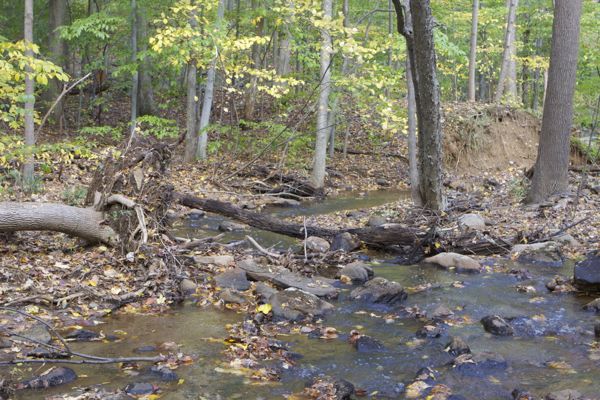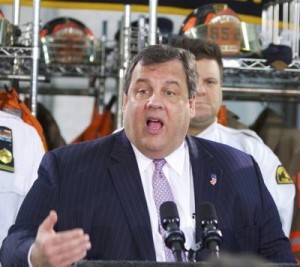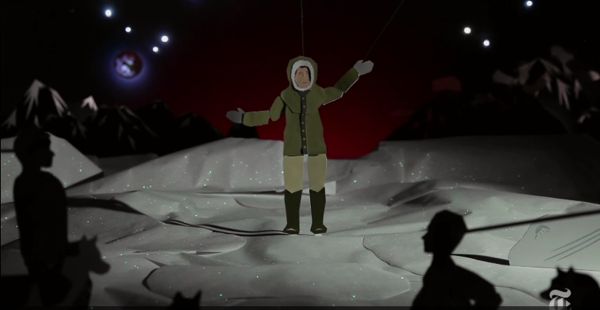Christie DEP’s Political Spin Infects DEP Science and Water Quality Report
DEP’s Recent Favorable Conclusions on Fenimore Landfill Are a Sham
We shall seek EPA Region 2 and EPA Inspector General review of this matter

stream just below Fenimore landfill. Severe erosion, physical impairment. Even if leachate seeps had no impact, runoff from landfill creates erosion and sedimentation. DEP claims sediment is #2 cause of impairment to Drakes Brook.
After almost a year of foot dragging, this week DEP finally released water quality documents, originally requested in our April 25, 2014 Open Public Records Act request that DEP denied, regarding the impacts of Fenimore Landfill on nearby streams.
The DEP’s new water quality assessment directly contradicts years of prior studies, including the current legally binding 2012 “Impaired Waters List” required by the federal Clean Water Act.
Specifically, DEP just released a September 2014 “Stressor Identification of Drakes Brook’ (if the Report was final in September, why did it take 5 months to be released? Perhaps maybe because it could have had an impact on the closure of the landfill?)
The new DEP Report concludes, among other things:
Also, this study found that the Fenimore Landfill does not appear to be a major contributor to the impairment of the benthic macroinvertebrate communities in the downstream reaches of Drakes Brook covered by this investigation. This finding is based on the benthic macroinvertebrate sampling conducted at a station located on an unnamed tributary downstream of the landfill near Ledgewood Pond (DR-LB2) during this study which indicated a Good rating (including 30% sensitive taxa).
There are several red flag dead giveaway anomalies that jump right out of that incidental “also” conclusion, which was curiously tacked on to the Executive Summary, seemingly dangling there without a purpose, but ostensibly put in the Executive Summary so it could be readily found by the public and unknowing lay readers based on a cursory review (akin to press release rigor).
First, no other potential “major contributor” was specifically named and determined NOT to be a problem.
There are dozens of potential “major contributors”, including toxic sites, major storm water outfalls, etc. None of them are named as “not” a major contributor. Take a look at the DEP’s recent original inventory of pollution targets. Good photos of Fenimore.
Second, note the qualifier DEP stuck on that conclusion: i.e. Fenimore “does not appear” to be a “major contributor”.
[The term “major contributor” is not defined in DEP’s most current EPA approved 2012 water quality assessment methods document. The term has no meaning and is highly subjective.]
Aside from the subjective judgment required to determine what “major” means, the use of “does not appear” is a stock euphemism that is the DEP scientist’s way of saying “we lack data to support this conclusion” (implicitly which is being dictated by our hack managers for political reasons).
Third, curiously, in a study designed to identify the causes and sources of impairment, the DEP did additional sampling just below Fenimore landfill to rule out the landfill, which is the opposite of the study’s objective:
The purpose of these additional biological monitoring stations was to trace how far upstream from AN0311 the biological degradation was actually occurring, and to rule out contributing portions of the Drakes Brook sub-watershed as sources of stress to the stream biota.
Fourth, and this is the most important point and a smoking gun: when a water quality impairment is found, all major potential pollution sources, like landfills, are presumptively considered to be a contributing source. Because prior DEP field investigations verified visual observations of landfill leachate seeps at Fenimore, the only way to overcome this presumption is with conclusive sampling data from Fenimore leachate showing no pollutant levels of concern that could cause or contribute to the water quality impairment.
However, in an odd and significant departure from standard scientific and regulatory methods, the DEP did just the opposite: they concluded that Fenimore was NOT a pollution source based on NO DATA:
Nutrient and organic enrichment from the Quality Inn effluent and/or Fenimore landfill leachate: While the Quality Inn effluent and Fenimore landfill leachate were not directly sampled for this study, their effects on the benthic community at AN0311, at the time of this investigation, seem limited at best, based on results of stream nutrient and BOD sampling in the watershed. (@p. 24)
The DEP did not sample the Fenimore leachate seeps that their own prior field investigation determined were a potential source of the problem. Yet, without data, the DEP now concludes that Fenimore is NOT a problem.
Fifth, DEP tried to mask their deception.
Specifically: DEP ignored and omitted a current field investigation that identified the Fenimore Landfill as a major pollution source. While they ignore current negative findings, DEP reaches back 40 years to select very old data to create a false impression that all prior DEP concerns about Fenimore pollution are 40 years old (and thus not reliable or recent):
Additionally, this study finds that the Fenimore Landfill does not appear to be a major contributor to the impairment of the benthic macroinvertebrate communities in the downstream reaches of Drakes Brook covered by this investigation. This is based upon the benthic macroinvertebrate sampling conducted at a station located on an unnamed tributary upstream of Ledgewood Pond (DR-LB2) which indicated a Good rating (including 30% sensitive EPT taxa). This is contrary to previous NJDEP studies from 1975-76 which indicated significant degradation to Drakes Brook being caused by the landfill.
Last, DEP relies on and cites two studies that do not meet DEP’s own QA/QC requirements and are not germane to water quality (see studies cited in footnotes #14 and #16).
It is one thing for the DEP press office to spin information and sometimes even make embarrassing mistakes, like calling old landfill leachate seeps “natural”. The Press Office is staffed by reporters and their spin has no regulatory significance.
Similarly, it’s extremely embarrassing – but of no regulatory significance – when the political patronage hack that manages DEP’s Office of Intergovernmental Affairs – Commissioner Bob Martin’s Bridgette Kelly – describes sycamores along the Delaware River in Bulls Island State Park an “invasive species”.
But, when DEP regulatory documents – funded by EPA and the basis of EPA delegated Clean Water Act programs – start spinning the data, then that is a completely different kettle of fish and is a serious problem. Follow me as I lay this all out.
- The Fenimore Saga of Deceit
On October 15, 2011, before the controversial disposal and odor problems emerged, I toured the Fenimore landfill in Roxbury NJ. The landfill drains to a stream known as Drakes Brook.
I wasn’t out on a picnic – I began my career in DEP in 1985 in the solid waste program, was part of the team that wrote the first Statewide Landfill Closure Plan in the late 1980’s, was involved in developing DEP’s Watershed Planning initiative in the early 1990’s, and I subsequently drafted the environmental provisions of the 2004 Highlands Act. After leaving DEP in 2004, I then served as a consultant to the Highlands Coalition to lead the effort on participating in DEP’s drafting of the implementation rules.
1. Field Visit
On October 15, 2011, I walked the entire perimeter of the landfill and took a lot of pictures of many environmental problems I saw, including leachate seeps, solid waste, including old drums, in the woods and in streams, and negatively impacted streams. I posted some of those photos on October 16, 2011, under this note:
Highlands Hike – The Landfill Loop Trail
This article set me out to Roxbury for a field visit to the Fenimore Landfill for photos for a post on why the Highlands Act provided the Council with strong power to influence DEP cleanup of contaminated sites.
You find the darndest things hiking NJ trails – stuff like this:
While the issue has got zero media attention, the controversial Fenimore landfill is polluting not only the air, but nearby surface water (streams) and groundwater.
2. Sham Consultant’s Report claims “no impact”
Over 2 years after that first visit, after the Fenimore debate exploded, on April 16, 2014, I wrote a post that exposed false and misleading statements in a Roxbury Township’s consultant Report about the Fenimore landfill’s impact on the stream the landfill drains to, know as Drakes Brook. Specifically, that Report found:
Sampling of these streams as recent as March 2013 did not show any impacts from the landfill
I noted that that conclusion of ‘no impact” from the landfill was based on studies that had nothing to do with water quality and that it contradicted prior DEP conclusions that the Drakes Brook was impaired and that Fenimore landfill was a source of the problem. Read the entire post for the details and links to the documents.
Specifically, in a 2008 Ambient BioMonitoring Network Report, based upon data collected in 204, the DEP determined that Drakes Brook, at Emmans Road in Roxbury, was “moderately impaired” for the “aquatic life support” use designation.
In a subsequent intensive DEP field investigation Report to determine the causes and sources of impairment and pollution to Drakes Brook, “Stressor Indicators: In Search of a Cause”, DEP specifically identified Fenimore Landfill, including “many landfill leachate seeps” and a “leachate pond” as contributing to the impairment of Drake Brook.
Take a look at the framework of that DEP study, there are a number of maps and photographs that show Fenimore Landfill.
Based upon the DEP findings and my own visual observations, there is no way the landfill was having “no impact” on Drakes Brook as the consultant stated.
3. DEP Denies Public Records Request for the Documents – Lies to Press about impairment
On June 11, 2014, NJ PEER issued a press release, primarily to do a national distribution of the local group REACT’s Report.
Specifically, PEER made this claim:
… what neither the residents of Roxbury nor SEP knew was that state DEP biological monitoring data showed that the two streams running around the landfill were impaired. This Stressor Indicator report is based on sampling studies from 2009-2010 showing the deleterious impacts on aquatic life in the Drakes Brook watershed from Fenimore.
In that press release, we also criticized DEP’s unusual denial of our April 25, 2014 OPRA public records request for the DEP’s own water quality studies on Drakes Brook that showed that the stream was impaired and there were negative impacts from the landfill.
The PEER press release got covered in a June 25, 2014 Engineering NEws Report story “NJ Landfill Mired in Turmoil”, in which DEP press office was quoted as follows:
Wolfe says biological monitoring data shows that two streams running around the landfill were impaired. Had that information been made public, the Fenimore never would have received a re-opening permit from the DEP, the site would not have been declared a brownfield site, and the solar project would not have gone forward, Wolfe alleges. The report that includes the biological monitoring data from 2010 “is not a draft—it is being withheld because its findings are deeply embarrassing to the Christie people,” he says.
Ragonese denies that the draft report shows anything abnormal, and adds that the final report—part of a routine watershed analysis—will be released in coming weeks. Also this summer, NJDEP plans to put out a request for proposals to cap the site, and begin work on closing the landfill before the end of the year.
I explained and documented why DEP’s denial of the OPRA request (on the basis of the deliberative privilege exemption) and Ragonese’s statements where false in a June 25, 2014 post, which included additional DEP documentation from the DEP’s EPA approved 2012 Clean Water Act Section “303(d) Impaired Waters List” (2012) that listed Drakes Brook as “impaired”.
So there it is folks. Let’s summarize:
DEP’s political masters have pressured the DEP science an water quality assessment staffers to spin the data and absolve Fenimore landfill as a source of pollution. They reached this conclusion, which contradicted prior field investigations, based on no actual Fenimore leachate seep data – or groundwater monitoring data.
Because this is a federally funded and delegated program, we shall seek EPA Region 2 and EPA Inspector General review of this whole matter.
We will keep you posted.

